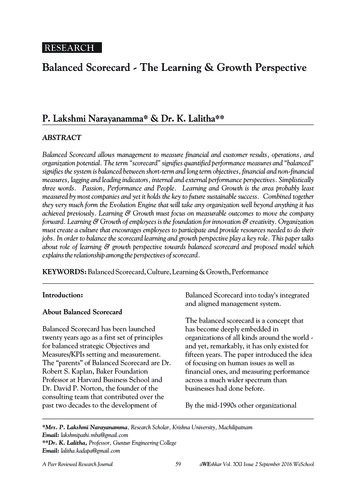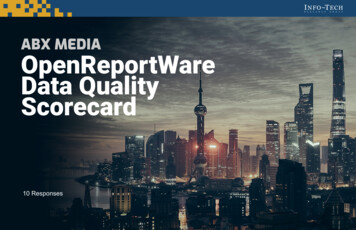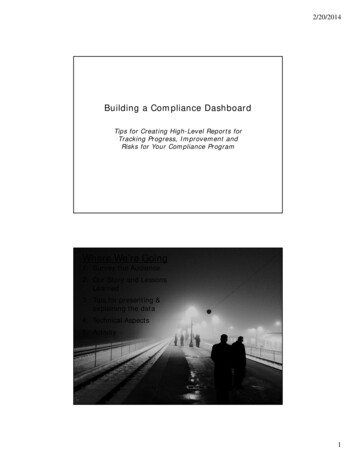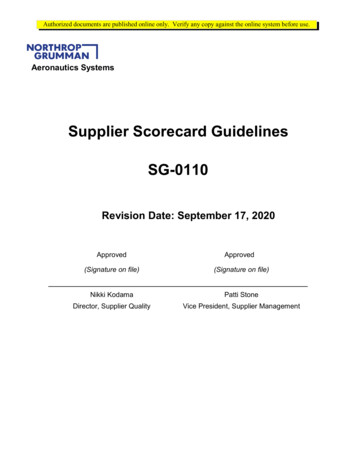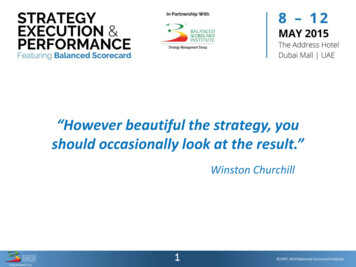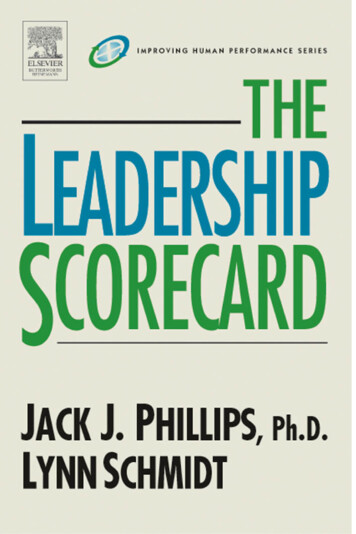
Transcription
TH E L EAD E R S H I P SCO R E CAR D
Series Editor: Jack J. Phillips, Ph.D.LATEST BOOKS IN THE SERIESThe Leadership ScorecardJack J. Phillips and Lynn SchmidtBottom-Line Call Center ManagementDavid L. ButlerBottom-Line Organization DevelopmentMerrill AndersonThe Diversity ScorecardEdward E. HubbardHandbook of Training Evaluation and Measurement Methods, 3rd EditionJack J. PhillipsThe Human Resources ScorecardJack J. Phillips, Patricia Pulliam Phillips, and Ron D. StoneManaging Employee RetentionJack J. Phillips and Adele O. ConnellThe Project Management ScorecardJack J. Phillips, G. Lynne Snead, and Timothy W. BothellReturn on Investment in Training and Performance Improvement Programs, Second EditionJack J. PhillipsVisit http://books.elsevier.com/humanresources to see the full range of books availablein the series.
TH E LEADE RSH I PSCORECARDJACK J. PHILLIPS, Ph.D.LYNN SCHMIDTAMSTERDAM BOSTON HEIDELBERG LONDONNEW YORK OXFORD PARIS SAN DIEGOSAN FRANCISCO SINGAPORE SYDNEY
Elsevier Butterworth–Heinemann200 Wheeler Road, Burlington, MA 01803, USALinacre House, Jordan Hill, Oxford OX2 8DP, UKCopyright 2004, Jack J. Phillips and Lynn Schmidt. All rights reserved.No part of this publication may be reproduced, stored in a retrieval system, or transmittedin any form or by any means, electronic, mechanical, photocopying, recording, orotherwise, without the prior written permission of the publisher.Permissions may be sought directly from Elsevier’s Science & Technology RightsDepartment in Oxford, UK: phone: ( 44) 1865 843830, fax: ( 44) 1865 853333, e-mail:permissions@elsevier.com.uk. You may also complete your request on-line via the Elsevierhomepage (http://elsevier.com), by selecting “Customer Support” and then “ObtainingPermissions.”Recognizing the importance of preserving what has been written, Elsevier prints its bookson acid-free paper whenever possible.Library of Congress Cataloging-in-Publication DataPhillips, Jack J., 1945–The leadership scorecard/Jack J. Phillips, Lynn Schmidt.p. cm. – (Improving human performance series)Includes bibliographical references and index.ISBN 0-7506-7764-3 (alk. paper)1. Leadership–Evaluation. 2. Executives–Training of–Evaluation. I. Schmidt, Lynn.II. Title. III. Series.HD57.7.P494 2004658.4 092–dc222004046953British Library Cataloguing-in-Publication DataA catalogue record for this book is available from the British Library.ISBN: 0-7506-7764-3For information on all Butterworth–Heinemann publications visit our Web site atwww.bh.com04 05 06 07 08 09 10 8 7 6 5 4 3 2 1Printed in the United States of America
ContentsPreface, xiAcknowledgments, xviiPart I Leadership Scorecard Foundation, 11Developing Leaders, 3The Leadership Development Imperative, 3Leadership Development Challenges, 5Leadership Development Methods, 7Feedback, 9Challenging Experiences, 11Formal Developmental Relationships, 16Leadership Training, 21Reflection, 22Leadership Development Accountability, 23Final Thoughts, 26References, 272Creating the Leadership Scorecard, 31Leadership Scorecard Pre-Work, 32The Leadership Scorecard Foundation, 33An Evaluation Framework, 34The ROI Model, 36Operating Standards and Philosophy, 49Implementation Issues, 50Application and Practice, 51Leadership Scorecard Benefits, 51Final Thoughts, 52Introduction to Case Study, 54Case Study—Part A—International Car Rental, 54v
viContentsDiscussion Questions, 57References, 57Part II Leadership Scorecard Methodology, 593Measuring Indicators, Satisfaction, and Learning, 61Measuring Indicators, 61Measuring Satisfaction, 63Questionnaires and Surveys, 63Using Satisfaction Data, 69Measuring Learning, 70Testing, 70Administrative Issues, 75Final Thoughts, 76Case Study—Part B—International Car Rental, 76Discussion Questions, 77References, 794Measuring Application and Business Impact, 80Questionnaires, 81Interviews, 88Focus Groups, 91Observations, 92Business Performance Monitoring, 95Action Planning and Follow-Up Assignments, 97Performance Contracts, 104Selecting the Appropriate Method, 106Data Tabulation Issues, 109Shortcut Ways to Measure Application and Business Impact, 110Final Thoughts, 110Case Study—Part C—International Car Rental, 111Discuss Questions, 111References, 1155Isolating the Effects of a Leadership DevelopmentProgram, 116Preliminary Issues, 116Use of Control Groups, 121Trend Line Analysis, 124Forecasting Methods, 126Participants’ Estimate of Leadership Development Impact, 128
ContentsviiManagement Estimate of Leadership Development’s Impact, 137Subordinate Input on Leadership Development’s Impact, 139Calculating the Impact of Other Factors, 139Using the Techniques, 140Final Thoughts, 141Case Study—Part D—International Car Rental, 141Discussion Questions, 143References, 1436Converting Business Measures to Monetary Values, 145Preliminary Issues, 145Techniques for Converting Data to Monetary Values, 149Converting Output Data to Contribution, 149Calculating the Cost of Quality, 152Converting Employee Time, 153Using Historical Costs, 154Using Internal and External Experts’ Input, 155Using Values from External Databases, 156Using Estimates from Participants, 158Using Estimates from Immediate Managers, 159Linking with Other Measures, 159Using Leadership Development Staff Estimates, 161Selecting the Appropriate Measures, 161Accuracy and Credibility of Data, 163Final Thoughts, 166Case Study—Part E—International Car Rental, 166Converting Business Measures to Monetary Values, 167Discussion Questions, 168References, 1687Tabulating Leadership Development Program Costs, 169Cost Strategies, 169Cost Tracking Issues, 172Major Cost Categories, 175Cost Reporting, 180Cost Accumulation and Estimation, 180Final Thoughts, 184Case Study—Part F—International Car Rental, 186Discussion Questions, 187References, 187
viii8ContentsCalculating the Return on Investment, 189Basic ROI Issues, 189ROI Interpretation, 192Final Thoughts, 203Case Study—Part G—International Car Rental, 203Discussion Questions, 204References, 2059Identifying the Intangible Benefits, 206Key Issues, 206Typical Intangible Measures, 213Final Thoughts, 222Case Study—Part H—International Car Rental, 222Discussion Questions, 224References, 224Part III Leadership Scorecard ImplementationConsiderations, 22510Communicating Results and Overcoming Resistance, 227The Importance of Communication, 227Principles of Communicating Results, 229Analyzing Communication Needs, 231Planning the Communication, 233Developing the Information: The Formal Evaluation Report, 236Communicating the Information, 240Analyzing Reactions to Communication, 243Overcoming Resistance to a Leadership Measurement, 244Planning the Implementation, 245Cost-Savings Approaches, 248Final Thoughts, 251Case Study—Part I—International Car Rental, 252Discussion Questions, 253References, 25311Forecasting an ROI, 254Why Forecast an ROI?, 254The Trade-Offs of Forecasting, 256Preprogram ROI Forecasting, 258Forecasting with a Pilot Program, 262
ContentsForecasting ROI with Reaction Data, 263Forecasting ROI with Learning Data, 265Forecasting ROI with Skills and Competencies, 268Forecasting Guidelines, 270Final Thoughts, 272Case Study—Part J—International Car Rental, 273References, 274PART IV12Leadership Scorecard Case Studies, 275Developing Leaders at Imperial National Bank, 277Background, 277Data Collection Plan, 279Reaction and Learning, 285Application, 286Business Impact, 288Program Costs, 293ROI Analysis, 294Intangible Benefits, 297Results, 298The Author, 300Index, 303About the Authors, 319ix
PrefaceLeadership Development AccountabilityLeadership development continues to be one of the most challenging and intriguing issues facing organizations. The interest inleadership development continues to grow year after year. The topicappears on many conference and convention agendas. Articlesappear regularly in practitioner and research journals. Books continue to be developed on the topic and consulting firms continue totackle this critical and important issue.Along with the interest in leadership development comes theinterest in accountability. Several issues are driving the increasedinterest in accountability. Pressure from clients and senior managersto show the return on their leadership development investment isprobably the most influential driver. Competitive economic pressures are causing intense scrutiny of all expenditures, includingall leadership development costs. Total quality management, reengineering, and Six Sigma have created a renewed interest in measurement and evaluation, including measuring the effectiveness ofleadership development. The general trend toward accountabilitywith all staff support groups is causing some leadership development departments to measure their contribution. These and otherfactors have created an unprecedented wave of applications for aleadership scorecard.Needed: A Leadership ScorecardWhat is needed is a rational, logical approach to measurement andevaluation that can be simplified and implemented within the currentbudget constraints and resources of the organization. This book presents a proven scorecard methodology based on almost 20 years ofdevelopment and improvement. It is a process that is rich in tradixi
xiiPrefacetion and refined to meet the demands facing leadership developmentdepartments.The scorecard methodology described in this book meets therequirements of three very important groups. First, the practitioners who have used this model and have implemented the scorecardprocess in their organizations continue to report their satisfactionwith the process and the success that it has achieved. This scorecard methodology is user-friendly, easy to understand, and has beenproven to pay for itself time and time again. A second importantgroup, the clients and senior managers who must approve leadership development budgets, want measurable results, preferablyexpressed as a return on investment. The scorecard methodologypresented here has fared well with these groups. Senior managersview the process as credible, logical, practical, and easy to understand from their perspective. More importantly, it has their buy-inthat is critical for their future support. The third important groupis the evaluation researchers who develop, explore, and analyze newprocesses and techniques. When exposed to this methodology in atwo-day or one-week workshop, the researchers, without exception,give this process very high marks. They often applaud the techniques for isolating the effects of training and the techniques forconverting data to monetary values. Unanimously, they characterize the process as an important—and needed—contribution to thefield.Why This Book at This Time?Currently there is no book that offers a comprehensive, practicalpresentation on a leadership scorecard that uses a process that meetsthe demands of the three groups previously described. Most modelsand representations of the scorecard process ignore, or provide verylittle insight into, the two key elements essential to developingthe scorecard: isolating the effects of the leadership developmentprogram and converting data to monetary values. Because there aremany other factors that will have an influence on output results, thisbook provides various strategies to isolate the effects of the leadership development program, far more than any other presentation onthe topic. Not enough attention has been provided to the issue ofassigning monetary values to the benefits derived from quality leadership development programs. This book presents various strategiesfor converting data to monetary values.
PrefacexiiiTarget AudienceThis book should be of interest to anyone involved in leadershipdevelopment including the leaders themselves. The primary audiencefor this book is executives, managers, and professionals involved inleadership development, coaching and mentoring programs, actionlearning projects, training, and performance improvement. Whetheran individual is involved in needs assessment, instructional design,delivery, evaluation, or is a participant, this book will be an indispensable reference. Individuals in leadership development and inleadership positions (i.e., managers, supervisors, team leaders, directors, and vice presidents) will find it to be a helpful guide to measurement and evaluation. With its step-by-step approach and casepresentations, it will also be useful as a self-study guide.Structure of the BookThis book has two unique features that make it a very usefulguide. First, it presents the scorecard model in a step-by-step process.The second unique feature is an application of the scorecard in adetailed case study that is based on an actual situation. The case isdivided into ten parts. One part is included at the end of each chapter,beginning with Chapter 2. Readers can work through the case, stepby-step, exploring the issues uncovered in the chapter and learn howto apply them to their own organizations. The results of each partare presented in the next chapter where a new issue is addressed.This case presentation is a proven learning tool to understanding thescorecard process.Chapter DescriptionsChapter 1: Developing Leaders. This chapter reviews the current leadership development issues and challenges that organizations experience. A variety of leadership development methods aredescribed in detail. The need for accountability is addressed.Chapter 2: Creating the Leadership Scorecard. This chapter introduces the scorecard process and addresses the need for implementing a leadership scorecard. The evaluation framework is introducedand an overview of data collection methods is provided.Chapter 3: Measuring Indicators, Satisfaction, and Learning. Thischapter presents a variety of approaches to one of the most fundamental issues. Ranging from conducting surveys to conducting tests,
xivPrefacethe most common ways to collect indicator, satisfaction, and learning data are described in this chapter. Useful tips and techniquesto help select the appropriate method for a specific situation arepresented.Chapter 4: Measuring Application and Business Impact. Thischapter addresses the critical issues concerning how to measure theapplication of skills on the job and the resulting impact to the business. A variety of data collection techniques are covered. The actionplanning process is introduced along with tips and techniques forusing the action planning process.Chapter 5: Isolating the Impact of a Leadership DevelopmentProgram. This chapter presents what is perhaps the most importantaspect of the scorecard process. Ranging from the use of a controlgroup arrangement to obtaining estimates directly from participants,the most useful techniques are presented for determining the amountof improvement directly linked to the leadership developmentprogram. The premise of this chapter is that there are many influences on business performance measures with leadership development being only one of them.Chapter 6: Converting Business Measures to Monetary Values.This chapter presents an essential step for developing an economicbenefit from leadership development. Ranging from determining theprofit contribution of an increased output to using expert opinion toassign a value to data, the most useful techniques to convert bothhard and soft data to monetary values are presented, along withmany examples.Chapter 7: Tabulating Leadership Development Program Costs.This chapter details specifically what types of costs should beincluded in the scorecard formula. Different categories and classifications of costs are explored in this chapter with the goal for developing a fully loaded cost profile for each return on investmentcalculation.Chapter 8: Calculating the Return on Investment. This chapterdescribes the actual ROI calculation and presents several issuessurrounding its development, calculation, use, and abuse. The mostaccepted ROI formulas are presented, along with examples to illustrate the calculation. Common ROI myths are dispelled.Chapter 9: Identifying the Intangible Benefits. This chapter focuseson non-monetary benefits from the program. Because not all measures can or should be converted to monetary values, this chaptershows how the intangible benefits should be identified, monitored,and reported. Over 25 common intangible benefits are examined.
PrefacexvChapter 10: Communicating Results and Overcoming Resistance.This chapter provides best-practice approaches for communicating leadership scorecard results. Information on how to plan forcommunications, select audiences and media, develop reports, andaddress typical issues that surface during communication is provided.The types of resistance that may be encountered when implementing a scorecard are identified along with tips and techniques for howto deal with the resistance.Chapter 11: Forecasting an ROI. This chapter shows how thereturn on investment can be used to forecast the payoff of a programbefore it is implemented. The chapter underscores the range of possibilities available for calculating the ROI at different time frames,using different types of data.Chapter 12: Developing Leaders at Imperial National Bank. Thischapter provides a case application that shows the monetary impactof an executive leadership program. This case study explores thecomplexity of measuring the impact of leadership development usingan action learning process. More importantly, this case shows howchanges in a program design can significantly increase the actualreturn on investment.Chapter 13: Executive Coaching: The ROI of Building LeadershipOne Executive at a Time. This chapter provides a case applicationthat shows the monetary benefit of executive coaching. A comprehensive study is outlined that evaluates coaching using the measuresthat are a part of the leadership scorecard. The case study providesrecommendations on how to increase the value of coaching for thebusiness.
AcknowledgmentsFROM JACK J. PHILLIPSNo book is the work of the author alone; many other individualsprovided input and support to make this effort a reality. I am particularly grateful for the clients I have had the opportunity to workwith in my years of consulting. I have learned from every assignmentinvolving leadership development and have translated that knowledge into this book. To all of my clients, I owe much appreciationfor their willingness to engage our services and experiment with ourapproach.Several individuals were very helpful in developing this manuscript. Many thanks go to my co-author, Lynn Schmidt, for developing much of this manuscript. She assumed this task on top of avery busy schedule and performed admirably with this huge challenge. Lynn understands leadership, development, and measurement.I would also like to thank Joyce Alff for her meticulous review,editing, and coordination.I would like to acknowledge the continued support and assistancefrom my spouse and partner, Patti Phillips, who always inspires meto do my best and supports me in all my work.Jack J. PhillipsFROM LYNN SCHMIDTEverything I know about leadership I have learned from books,classes and life, and from the leaders I have had the fortune tointeract with over the years. I have found leaders everywhere—corporations, universities, volunteer groups, non-profit organizations, social settings, and family gatherings. And in all types ofxvii
xviiiAcknowledgmentsroles—CEOs, assistants, teachers, clerks, friends, mothers, andbrothers. These individuals, whether they were leading billion-dollarcompanies or dinner conversations, demonstrated a competenceand strength that sparked my interest in leadership development. Iappreciate the opportunity that I have had to learn from theseindividuals and thank them all.Everything I know about measurement and evaluation I havelearned from books, classes, and a special group of people—theASTD ROI Network Advisory Committee. Special thanks go to themembers of that committee for providing me with the opportunityfor continuous learning: Jack J. Phillips, Patti Phillips, Toni Hodges,Merrill Anderson, Holly Burkett, Deb Wharff, Dan McLinden, JimChatt, Uichi Tsutsumi, Kyoko Watanabe, Bruce Aaron, DiederickStoel, Ed Hubbard, and Lizette Zuniga.I would also like to thank the behind-the-scenes support staff thatmade this book possible—Joyce Alff, the internal editor, and the staffat Elsevier/Butterworth–Heinemann. And a special note of appreciation to my three canine friends, Plato, Bailey, and Chipper, whospent many evenings waiting patiently for me to finish working onthe manuscript and who made sure that I took breaks whether Ithought I needed them or not.Note: Limited portions of this book were taken from two otherbooks that discuss the process. These sources are:Phillips, Jack J. Return on Investment in Training and Performance Improvement Programs, 2nd Edition, Boston: Butterworth–Heinemann, 2003.Phillips, Jack J., Ron D. Stone, and Patricia Pulliam Phillips.The Human Resources Scorecard. Boston: Butterworth–Heinemann, 2001.
PART ILeadership ScorecardFoundation
CHAPTER 1Developing Leaders“At the end of the day, it’s the top-flight leaders who make a business great.” Larry Bossidy, former CEO of AlliedSignal, spentapproximately 30 to 40 percent of his time hiring and developingleaders his first two years at AlliedSignal. He attributes AlliedSignal’ssuccess in large part to the commitment he made to leadershipdevelopment (Bossidy, 2001). Leadership continues to be a criticaldevelopmental focus for organizations around the world. Researchindicates that strong leadership has a positive impact on bottom-lineresults. Organizations with strong leadership bench strength economically outperform companies with weaker leadership.A Corporate Leadership Council study reports that 82 percent ofcompanies with strong leadership displayed above-average revenuegrowth over a six-month period (2001). In addition to increased salesand profitability, customer and employee satisfaction is higher fororganizations with strong leadership. A study conducted by theConference Board found that companies rating themselves as havingstrong leadership capacity appeared more often at the top ofFortune’s list of “Most Admired” companies and were almost twiceas likely to appear in the top quartile of the rankings (Csoka, 1998).Leading companies consider leadership development to be a businessimperative and a critical component of business strategy and succession management.The Leadership Development ImperativeSeveral factors are causing a multitude of changes in the worldand are having a significant impact on the way work gets done.Factors such as changing workforce, rapidly changing technology,and changing board requirements are causing organizations to takeproactive steps to plan for future leadership development.3
4The Leadership ScorecardWorkforce demographics are changing in a number of ways. Thenumber of retirees is expected to increase drastically while at thesame time there will be fewer entrants into the workforce. As a resultthere will be more job openings available than candidates to fill them.This leads to increased competition for leaders with the ability tolead today’s organizations. Increased competition requires additionalfocus on retaining leaders, thereby reducing the turnover of criticalleadership talent creating an ongoing need for leadership development programs.The changing demographics reflect greater diversity in the workplace—diversity with regard to race, gender, as well as generations.These changes lead to diverse employee needs. Young workers todayare more concerned with work/life balance, less accepting of traditional hierarchy, and less trusting of organizations. Leaders needcapabilities in the areas of people management, empowerment, andcommunication skills in order to lead a very diverse workforce.Leaders will need to be able to not only develop talent but also torecruit and retain top talent. This means that leaders will need tobecome more adept at designing more individualized, flexible workarrangements that are tailored to diverse needs (Barrett and Beeson,2001).Rapid changes in technology require that leaders be able to managethe changes brought on by technology and look for ways to apply newtechnology to business. While these changes do not require leaders tobe technological experts, they do require a priority of analytical skills.Leaders need to be able to quickly sort through all of the data to seepatterns and make good decisions (Barrett and Beeson, 2001).At many organizations the board of directors is focusing morestrongly on succession management and leadership development.Many board of directors are requiring that a talent pool of potential successors be identified and developed to eventually move intosenior leadership positions. This requires that leaders become thedevelopers of other leaders. Along with that, the board of directorsis also focused on governance issues and ensuring that the organizations leaders are operating in an ethical manner. This, along withthe financial expectations of stakeholders, requires that leadersbecome very ethically and financially astute.Additional changes brought on by deregulation, globalization, andincreased competition require that leaders become adept at strategicthinking, competitive positioning, and cultural awareness. Thesechanges place further pressure on organizations to invest in leadership development.
Developing Leaders5Leadership Development ChallengesThese changes in the way business gets done will have a significant impact on the quantity and quality of leadership talent. Asstudies have shown, strong leaders are essential to business success making leadership development a business imperative. Unfortunately, many organizations implement leadership developmentmethods that result in a poor investment of time and money. Organizations focused on wisely investing their time and money in effective leadership development methods that address the issues raisedearlier face four key challenges: accelerating the development of leadership talent;selecting effective leadership development methods;investing leadership development dollars wisely; anddemonstrating the success of leadership development methods.The lack of leadership talent in the pipeline presents a challengefor many organizations. Many organizations do not have the leadership talent necessary to sustain a competitive advantage. In a studyconducted by the Conference Board, only one-third of respondentsrated their company’s leadership capacity to meet business challengesas excellent or good. This requires organizations to proactively buildleadership bench strength for the future, as well as play catch-up andaccelerate the development of their current leaders. Even more disconcerting is the fact that less than one-half of the survey respondents reported that developing future leaders is a major priority fortheir organizations (Barrett and Beeson, 2001). This suggests thatover one-half of the organizations represented will not be focusingon leadership development until it is too late, too costly, or too timeintensive to accelerate the development of their leaders.Along with the challenge of accelerating leadership developmentcomes the challenge of selecting effective leadership developmentmethods. Research has shown that effective leadership development is achieved through a systems approach, by incorporating onand off- the job experiences with mentoring, coaching, or trainingall closely aligned with development plans and business strategy. Toaccelerate the development of a leader it is critical to ensure thatright development methods are used. Several sources suggest thata mix of leadership development methods is the most effectiveapproach to developing leaders (Barrett and Beeson, 2001; Byham,Smith, and Paese, 2001; Charan, Drotter, and Noel, 2001; Corporate
6The Leadership ScorecardOff the Job Experience(e.g., industryassociations, communityleadership)15%Education/Training10%On the Job Experience(e.g., enrichment/lateral/ Coaching/Personal Feedback20%Figure 1-1. Leadership development methods.Leadership Council, 2001, 2003; McCall, Lombardo, and Morrison,1988; McCauley, Moxley, and Van Velsor, 1998; Zenger andFolkman, 2002). Figure 1-1 indicates that 70 percent experiencesboth on and off the job, 20 percent mentoring or coaching and feedback, and 10 percent education and training are an effective mix ofleadership development methods.Selecting effective leadership development methods is challengingdue to “the productization of leadership development” (Ready andConger, 2003). Many leadership development efforts are not alignedwith business strategy; rather organizations are in search of a quickfix becoming focused on commercial products rather than the issuesthat need to be addressed. Many of these commercial products arebased on a current best-selling book. The problem does not residewith the authors of these books but with the misuse of these worksthat takes the form of quick fix training packages implemented byorganizations that have not diagnosed the business needs. As a result,organizations are unable to show a positive return on investmentfrom the programs and a significant investment in time and moneyis wasted (Ready and Conger, 2003).A division president at a Fortune 50 company was quoted assaying during a leadership development audit “We spend 120
Developing Leaders7million a year on this stuff, and if it all went away tomorrow, itwouldn’t matter one bit. Leadership development in this company isnothing more than a series of disconnected programs sold by consultants to training managers who don’t understand our business”(Ready and Conger, 2003). This indicates that another challengefacing organizations is investing leadership development dollarswisely. The education and development of lead
leadership scorecard. Needed: A Leadership Scorecard What is needed is a rational, logical approach to measurement and evaluation that can be simplified and implemented within the current budget constraints and resources of the organization. This book pre-sents a proven scorecard methodology based on almost 20 years of development and improvement.


